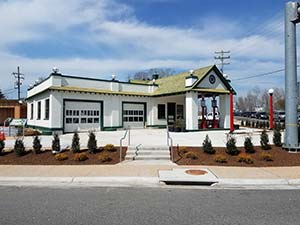Last Friday, the Fairfield Foundation and the Gloucester Main Street Preservation Trust (GMSPT) co-hosted the winter meeting of the Council of Virginia Archaeologists (COVA). COVA is Virginia’s professional archaeology organization, and is dedicated to the preservation and study of Virginia’s archaeological resources through fostering public awareness, advancing archaeological knowledge, and facilitating interaction between professional and avocational archaeologists and Virginia’s Department of Historic Resources (DHR). The turnout was fantastic – more than 40 professional archaeologists from across Virginia traveled to Gloucester, some of them braving severe weather, and allowed us to guide them around Gloucester’s historic village. The program included a presentation on current archaeology on the Middle Peninsula, a tour of the CAPE, the COVA business meeting, and a tour of Werowocomoco. In between, we enjoyed lunch at some of the great restaurants along Main Street, including longtime supporters of the Fairfield Foundation Bangkok Noi and 6655 Main. We would like to thank the GMSPT for providing a such a great venue for this gathering.
For those that weren’t present, here’s the cliff notes version of the presentation about archaeology on the Middle Peninsula, just highlighting some of our recent projects!
Fort Nonsense, Mathews County
In preparation for the opening of Mathews County’s first historical park, DATA Investigations staff excavated 28 2.5’ x 2.5’ units, as well as a number of shovel test pits, on the 2.8 acre property encompassing the remains of well-preserved Civil War era earthworks, where Confederate soldiers and other laborers created defenses to repel a potential attack by the Union army which never occurred. Archaeologists excavated at the locations of footings in advance of an elevated boardwalk, which along with a pathway, leads visitor throughout the park. Surprisingly, excavations did not result in the recovery of any artifacts that can be conclusively associated with the Civil War occupation of this fort. Aside from relatively modern trash deposits on the property (predominantly glass bottles), the only artifacts recovered date to the 18th-century. These artifacts include wine bottle glass, wrought nails, slipware, tin-glazed earthenware, white salt-glazed stoneware, other coarse earthenwares, imported tobacco pipe fragments, and brick fragments.
The recovery of these artifacts indicates a colonial occupation dating to the first half of the 18th century, the nature of which has yet to be determined. The soil layers observed during excavation, particularly near the primary fortification berm, suggest that additional ditches and other features were located in the fort, or perhaps preceded it. These appear to have been filled in during the construction of the fort, or afterwards as the fort eroded and was partially leveled. Future archaeological excavations at this site have the potential to shed light on the 18th-century occupation at this important local crossroads.
Gloucester Courthouse Area, Gloucester County
Building on work completed a couple of years ago surrounding Gloucester County’s historic Courthouse Circle, which contains the standing 1766 courthouse and several 19th-century county buildings, we have been conducting focused excavations at various points inside and near the court circle to answer specific questions about historic features and buildings located in this area, and at the same time help the county to better plan for future utility upgrades, historic building restoration, and public interpretation of this important space. While searching for the corner of a building located two years ago, excavations adjacent to the court circle wall uncovered a small, two-brick wide section of another brick foundation from a previously undocumented 18th-century building.
It is surprising that this portion of a foundation even remains intact, given the extent of disturbance by modern utility lines across this unit, as well as the 1930s brick wall and adjacent roadway. After removing soil layers related to the utility lines, we also located an approximately 1.5’ square posthole with mold, containing a complete tobacco pipe bowl, adjacent to the small section of intact brick foundation. This could be evidence of another building or fence line related to one of the several colonial structures in this area. A few feet to the north of this first unit, another test unit revealed more modern utility lines, but surviving on either side of a deep pipe trench was a thin layer of intact 18th-century topsoil.
The artifacts recovered from this layer included tin-glazed earthenware, imported tobacco pipe fragments, wine bottle glass, table glass fragments, and wrought nails. Excavation of the utility trench revealed the profile of two smaller potential postholes, as well as the original builder’s trench for a colonial structure that predates the standing 1766 courthouse. As we analyze these findings and map out the features identified to date, we will have a much better understanding of the village’s 18th-century layout.
The Middle Peninsula is a very historic place, and its story can be told through the surviving buildings, buried archaeological sites, and unrecorded stories of the people who live here. The Fairfield Foundation is dedicated to researching and preserving this heritage, and our various projects take us across the peninsula and cover many different topics, from colonial plantations and historic mills, to post-Civil War African-American communities and 20th-century oral history. We encourage you to get in touch and get involved with preserving and celebrating the Middle Peninsula’s stories.

